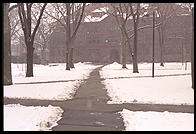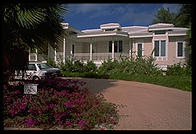

Sure, the Caymans were famous for SCUBA diving, windsurfing, white sand, and turquoise water. Yet could that compare to the visual satisfaction of seeing the same filthy ice-encrusted snow heaped up on one's driveway every day for three weeks? Would biking 35 kilometers a day be as good exercise as shoveling snow? I had to find out.
On Monday, January 17, 1994, I stepped out of Owen Roberts Airport on Grand Cayman to settle this burning question. My friend Bob picked me up and whisked me back to his house on isolated Rum Point. A red-tiled driveway encircling purple bougainvilleas fronts the broad pink stucco house. We walked past hibiscus blooming red and yellow into a white-tiled living room over which an 8-meter high ceiling floated. All the furniture was light-colored rattan and glass. It was like a temple to peace and light.


"Is that your bedroom?" I asked, pointing to a room on the right so large that the king-sized bed looked like doll house furniture.
"No, it's yours," Bob responded.
One of my bedroom walls was glass and slid open to the house-sized screen porch behind. Beyond the screen was soft white sand in front of the nicest stretch of ocean I've ever seen. The first 100 meters or so was only about one meter deep and hence a very light green in color. The next couple of hundred meters was the sparkling turquoise that so often looks too good to be true in advertisements for the Caribbean. As the water met the Cayman Wall, a coral reef that protects nearly the entire island from waves larger than about 20 cm, it turned a dark blue in color and then met the medium blue sky.
Bob and I went for a 20 km. bike ride past mangrove- lined beaches, cemeteries, wood-framed gospel churches, and millionaires' houses. The cemeteries are sparkling white, filled with flowers, and invariably by the beach. Coffins reside in large white stone vaults with heavy lids. For a place with 22,000 inhabitants, Grand Cayman has an astonishing number of these lovely cemeteries.
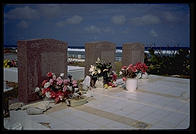
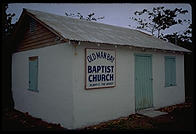
As the red sun hovered low over the water behind Bob's porch, I donned my snorkel gear and swam out into the warm clear water. Three spotted eagle rays, one with a tail at least 10 feet long, kept me company as the sun sank below the horizon and lit the undersides of the clouds like burning charcoal. I looked back towards Bob's house and, behind the palm trees jutting out over other beachside mansions, the sky melted from periwinkle to magenta back to periwinkle.
It was an OK first day, I guess, but I really missed shoveling snow then coming into Tech Square to stare at a UNIX box until 3 a.m.

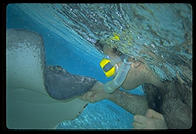
"Just keep a piece of squid in your fist and they'll come to you," Fergie instructed, "When you want to give up the squid, just open your fist and she'll suck up the food. They've got no teeth, but they generate more suction than a Hoover. You don't have to open your fist if you don't want to. You can lead them around with your hand."
It was fun to feed and lead the rays, but kind of shocking when other rays would brush my legs from behind. Their soft underbellies had a surprising texture for a member of the shark class, although their top surface was a bit abrasive.
I spent the rest of the day biking and reading on Bob's beachside porch.
 Dave and Rhonda, a Canadian couple, gave me a lift into
bustling Georgetown, 45 minutes away by car and completely
different in spirit from Rum Point. Four cruise ships were
in port and the trinket shops were overflowing with dentists
from New Jersey.
Dave and Rhonda, a Canadian couple, gave me a lift into
bustling Georgetown, 45 minutes away by car and completely
different in spirit from Rum Point. Four cruise ships were
in port and the trinket shops were overflowing with dentists
from New Jersey.

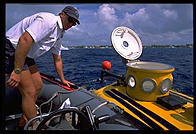
I hopped into Atlantis Research Submersibles Ltd.'s PC 1203 sub. Two passengers sit on cushions thrust up against an acrylic dome three feet in diameter. The ship is rated for 1000 feet and has lead-acid batteries good for 176 hours of life support. We dove to the wreck of the Kirk Pride a freighter that went down in 1985 in 800 feet of water.
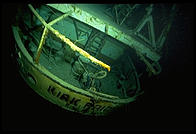

Despite some noise from pumps and engines, the spiritual peace of being down in the deep blue was almost worth the $275 price. We could see hundreds of feet in the dim light as our eyes adjusted and there was a preternatural clarity to everything. A few small fish darted around the mostly intact wreck.
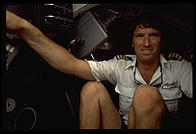 As we rose up the Cayman Wall, built up 30,000 years ago
during the Ice Age when the ocean level was 500-700 feet
lower than today, our pilot Troy turned on the ship lights
and explained all the strange creatures we saw.
As we rose up the Cayman Wall, built up 30,000 years ago
during the Ice Age when the ocean level was 500-700 feet
lower than today, our pilot Troy turned on the ship lights
and explained all the strange creatures we saw.
"No plants grow below 300 feet. Everything you see here
is an animal."
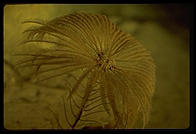
My favorite were spiny animals that grab and climb rocks with a bunch of tentacles on the bottom and then blossom out into a dandelion-like head. They are called crinoids and predate dinosaurs by several hundred million years, according to Jonathan Rees.
We saw a lot of human debris: a beach umbrella blow down to 800' just a few days ago, beer cans, bottles, etc.
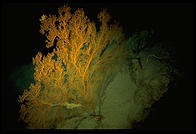 "I've been diving for nine years all over the ocean and
everywhere I've been I've seen this kind of trash. It isn't
just because we're right in Georgetown Harbor," Troy
lamented. "Cruise ships still dump all their trash
overboard every day.
"I've been diving for nine years all over the ocean and
everywhere I've been I've seen this kind of trash. It isn't
just because we're right in Georgetown Harbor," Troy
lamented. "Cruise ships still dump all their trash
overboard every day.
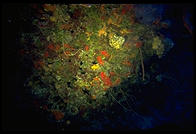 At 350 feet, we began to see really colorful sponges,
moray eels, and fish in the powerful lights. As I hoisted
myself out of the sub, I couldn't help thinking "that was
cool, but wouldn't it be more fun to get wedged with some
UNIX program and have to ask Brian to fix it?"
At 350 feet, we began to see really colorful sponges,
moray eels, and fish in the powerful lights. As I hoisted
myself out of the sub, I couldn't help thinking "that was
cool, but wouldn't it be more fun to get wedged with some
UNIX program and have to ask Brian to fix it?"
I hopped a cab up to Cemetery Beach to meet Rhonda and Dave and asked Agnes, born and raised in Cayman, about life here.
"The hardest thing about my life is seeing two husbands die in the same hospital. My first husband was a Caymanian sailor and he was stabbed to death. It was the first stabbing death in the islands. My second husband was an American. We lived in Colorado but he moved back here to be a tax consultant and died of an aneurism. I've got three kids, 32, 29, and 27. The two younger ones live at home with me, both working. I've got to drive until really late tonight to pay my phone bill. I've been calling my sister in the U.S. too much.
My daughter has ataxia and that leaves her physically and mentally handicapped. She's a sweet child, though, and makes beautiful pottery. She works at a Cayman center for handicapped crafts.
It was lovely to talk with you dear," Agnes gently noted as I got out.
Halfway back to Rum Point, we stopped at a burger shack on the southern coast of the island. The proprietor hacked up a few fishheads and tossed them into the surf. Half an hour later, three sinister hammerhead sharks, at least seven feet long, came into the shallows to feed under arc lamps pointed at the water. Sinister, yes, but as truly evil as your Ph.D. thesis advisor in a bad mood?
Bob and I sat around the pool and watched Magnificent Frigate Birds soar stationary in the stiff wind. A slender Argentinian with a perfect cocoa tan set off by her fluorescent thong bikini lounged next to us. She had the most wonderful open and friendly smile. Her husband, sporting a beer gut the size of a 55-gallon oil drum, lowered himself onto the chaise next to her.
"Why?" Bob asked in a low voice.
After a brief dip in the pool, we biked down the palm- lined untouched-by-tourism east coast of the island and back to Bob's. I trundled out a float and lay back as the current took me slowly past seven or eight houses in twenty minutes while I gazed up at clouds in the infinite sky.
"You don't need those patches, just take a couple ginger pills," say the New Age crowd. Well, I'd forgotten my Scopalamine patches back in Boston so I dropped a couple of ginger pills and stepped onto the 10-meter Rum Point Diver just before she ventured outside of the Cayman Wall. We'd been warned that it would be a rough day, but nothing prepared me for the mad tossing of the boat. After a few minutes of futile staring at the horizon, I began to feel sick.
"You can't get sick in the water," our divemaster had told a sufferer in Australia as she tossed him overboard.
I pushed my way past other divers and jumped off with my SCUBA unit.
Walls of water seemed to rush over me and it was tough to breathe through either my snorkel or mouth. I hung onto the assembly line from the boat, but the waves were so big that it was tough to see the boat at times. Between waves, it was impossible to see the shore as well.
After we'd descended to 25 meters, I began to feel better and enjoy the coral walls. Two beautiful spotted rays soared above the usual colorful reef fish. As the dive wore on, I began to feel sicker, especially as we ascended to surge-plagued shallower water for our 7 meter and 5 meter safety stops. I remembered that it was OK to throw up into one's regulator. I struggled out of my buoyancy compensator next to the transom as the boat crashed up and down about eight feet-enough force to smash in my head if I let the current take me half a meter closer to the boat (being pounded by the ladder or some other rigid part of the boat is one of the most common ways for divers to get injured).
As soon as I was sitting up on the transom, I vomited about five times to the mild amusement of the tanned perfectly V-bodied boat crew. We cruised through open water then ducked back inside the reef at world-famous Stingray City. I tried to just hug the bottom but surge and a strong current kicked me around. I really couldn't enjoy the stingrays surrounding other divers.
Visibility was terrible from algae and seaweed clumps floating by and particles stirred up by the surf and by our group floundering about on the bottom. We'd been cautioned not to go much beyond the bow of the boat because there was a strong current heading directly for Cuba that would push us through the Cayman Wall. Bob, my buddy for this dive, asked me to follow him so I did. Visibility worsened and the current grew stronger, but Bob kept swimming beyond the bow. I remembered his comment on the Los Angeles earthquake: "Wouldn't you have loved to be there, to feel the power?" I reflected that this wasn't the sort of sentiment that a novice diver wants in a dive buddy.
Bob eventually decided to stop pushing the envelope and we finned back towards the stern against the current. Rocks and coral fixed on the bottom betrayed the fact that our most vigorous kicking was only enabling us to hold our own.
Through a combination of finning and pulling myself along the sandy bottom, I made it back to the boat for a relatively vomit-free reboarding. I immediately retired to the front portion of the boat and lay down on a bench where a Frenchwoman established that I had both mal du mer and un peu de mal de tete. As she fed me aspirin, I translated Jackie Mason's "There's nothing sadder than a Jew with a boat" routine into French for her.
